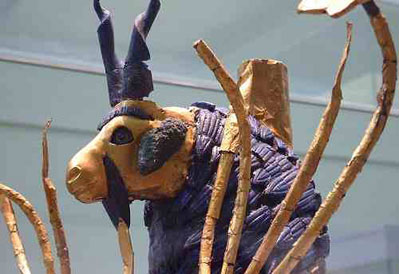
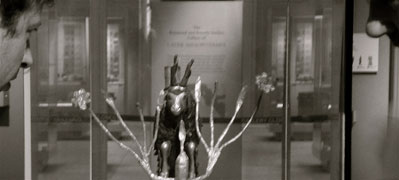
Portret bij het fameuze ‘Ram in a Thicket’. Links Thomas Raat, rechts ikzelf bij de ‘Ram in a Thicket’ in het ‘British Museum’. Het beeld blijkt moeilijk te fotograferen. De ram staat frontaal rechtop leunend op de vertakking in het struikgewas.
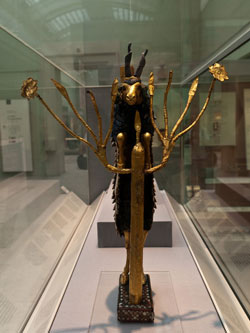
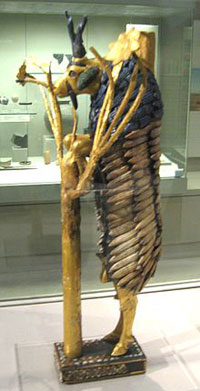
Een vreemd beeld in het British Museum, deze ‘Ram in a Thicket’, Great Death Pit, Ur. 2,500 BC.
Hun website:
The ‘ram’ is more accurately described as a goat, and he reaches up for the tastiest branches in a pose often adopted by goats. Goats and sheep in the Near East were among the earliest animals to be domesticated. They were an everyday feature of agricultural life and are regularly depicted by artists in many different ways.
Eigenlijk geen ram maar een geit. ‘Goat in a Thicket’.
The Ram in a Thicket is one of a pair of figures excavated in Ur, in southern Iraq, and which date from about 2600-2400 BC. One is currently exhibited in the Mesopotamia Gallery in Room 56 in the British Museum in London.
The ram’s head and legs are layered in gold leaf which had been hammered against the wood and stuck to it with a thin wash of bitumen, while its ears are copper but which are now green with verdigris. The horns and the fleece on its shoulders are of lapis lazuli, and the body’s fleece is made of shell, attached to a thicker coat of bitumen. The figure’s genitals are gold, while its belly was silver plate, now oxidised beyond restoration. The tree is also covered in gold leaf with gold flowers. The figure stands on a small rectangular base decorated with a mosaic of shell, red limestone and lapis lazuli. The figure was originally attached to the flowering shrub by silver chains around its fetlocks, but these chains have completely decayed. It is thought that the two figures originally faced each other as confronted animals, and that the tubes going up from their shoulders were used to support something, probably a bowl or similar object.
De vacht is vreemd. Gemaakt van schelpen, gelaagd met de uitstraling van een verentooi. Het bijzondere van het beeld is mede in de monumentaliteit ervan gelegen. Op een afbeelding is de grootte van de ram niet te schatten. Ik kende het beeld uit archeologische literatuur en was verrast hoe klein het bleek te zijn. Hoogte: 45.7 cm. Breedte: 30.4 cm. Vier en een half duizend jaar oud.
‘Ram in a Thicket’. De titel heeft een magische werking. Ram in het struikgewas. Het beest, merkwaardig rechtop staand als een mens op de achterpoten, lijkt te gluren tussen de takken door. Alsof het zich verstopt heeft. ‘Ram in a Thicket’ verwarde zich met de verbeelding van de latere Satan. Het leek in een soort an-archeologische terugblik alsof uit deze Ram het huidige Westerse beeld van de duivel gegroeid was. Ik dacht aan de bokkenpoten van de duivel. Diens gespleten hoeven en de gedraaide hoorns op het hoofd. De vacht van ‘Ram in a Thicket’ leken op zwarte vleugels, om het lichaam heen gevouwen. Die vleugels herinnerden aan de gevallen engel, Lucifer. Ik fabuleerde. ‘Ram in a Thicket’ is een merkwaardige geit.
Baphomet ziet eruit als een geit en het is die geit-duivel, de heraut van Satan, die de mensen verwarren met de ware Satan.

Uit 1821-1823 ‘Heksensabbat’ van Francisco de Goya (1746–1828).
Formaat 147 × 438 cm, collectie Prado Madrid.
A group of seated women offer their dead infant children to a seated goat.
Baphomet is an imagined pagan deity (i.e., a product of Christian folklore concerning pagans), revived in the 19th century as a figure of occultism and Satanism.
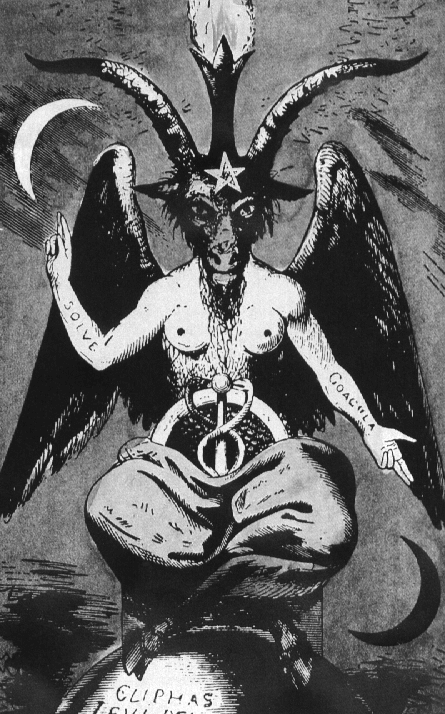

The 19th century image of a Sabbatic Goat, created by Eliphas Lévi. The arms bear the Latin words SOLVE (dissolve) and COAGULA (congeal).
Tarot card from the Rider-Waite tarot deck, ontwerp 1909.
Satan, de duivel of Lucifer is de gevallen (aarts-)engel, die door God uit de hemel werd geworpen toen deze tegen God in opstand kwam.
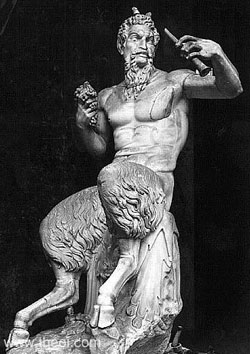
De mythische Griekse/Romeinse Pan of Faunus heeft het onderlijf en de hoorns van een geit, maar een menselijk bovenlijf.
Wikipedia.
Pan’s goatish image recalls conventional faun-like depictions of Satan.
… this specific association is modern and derives from Pan’s popularity in Victorian and Edwardian neopaganism. Medieval and early modern images of Satan tend, by contrast, to show generic semi-human monsters with horns, wings and clawed feet.
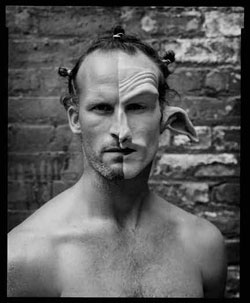
Halve faun Matthew Barney (1967) zie ook stuk ‘Halve gezichten, dubbele identiteit’, onder Mentaliteit.
De duivel kent vele gezichten.
Allart Lakke, december 2011.